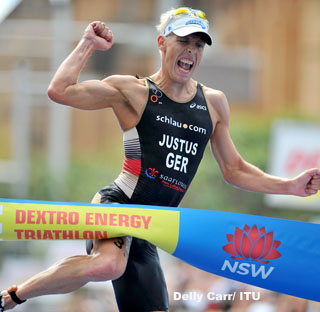Olympic Dreams In Peril

On April 10th many fans, professional triathletes, and even USA Triathlon, were shocked to see a completely different start list than they expected for the San Diego World Triathlon Series Race which will serve as the US Olympic qualifier. After years of racing, traveling across the globe and personal sacrifice most professionals were taken by complete surprise to see that a peculiarly timed WTS race and a severe breakdown of communication may have destroyed the Olympic dreams of many.
The cause of what many deem a fiasco dates to March 11th 2011 when a devastating tsunami landed on Japan decimating buildings, releasing nuclear waste, killing thousands and leaving a country desolate. The 2011 Yokohama WCS, scheduled for May 14th, was now just a distant afterthought and rescheduled for a date to be announced. No one could know at that time, but that rescheduled race would loom large over America’s Olympic qualification process.
The Yokohama event was rescheduled to take place one week after the ITU Grand Finale. The race was considered to be a throwaway as many opted for rest at the end of a long season. Many were unclear of the ramifications of racing such a peculiarly timed WTS. The 2011 season was over and the 2012 season was still six months away. The sentiment was reflected among many as it attracted one of the least competitive WTS fields ever, allowing many who would be lucky to get a WTS start to race to a high finish.
It was from this point there appeared to be a breakdown in communication between ITU, USAT and its athletes. No one was able to project the significance of the rescheduled race from so far out. At the time Yokohama entries were due, the 2011 season was still 2 races away from being completed, the 2012 WTS schedule had not be finalized and USA Triathlon was still defining their Olympic selection criteria as “an early 2012 WCS race.” Further muddling things, it was unclear how points awarded from Yokohama would be included on ITU’s many different points lists. Accumulated points were being applied to the first Olympic cycle despite the cycle ending 5 months prior.
Many triathletes were under the impression, or report they were led to believe by USAT, that Yokohama would not be the sole race dictating 30 entries to the US Olympic Trials. Professionals headed to far-off places like Mooloolaba, Australia, La Paz, Argentina and a collection of South American counties seeking to collect ITU points and move themselves higher up the ITU point list, which was thought to dictate the majority of San Diego entries.
As the cutoff for San Diego grew closer many triathletes rejoiced in their assumed qualification, prepared to face the next step toward realizing their Olympic dreams. Several took to their twitter feeds to voice their satisfaction. They had raced hard and performed well recently to climb the ITU points ladder. However, most were about to find out his strategy was based on bad information.
The start list was released and it set the Olympic Training Center abuzz. It was as if athletes, USAT management and high performance directors were finding out for the first time their Olympic strategy was based on completely different criteria than they had thought. The Yokohama results were included and awarded 30 spots, many going to lowly ranked competitors. After the 30 Yokohama entries and 7 entries from the Gold Group (a small collection of elite athletes including Olympic medalists and the highest 2011 finishers) that left just 28 spots available to be rolled down to the ITU points list. The result was a quizzical 65-man list which included the 174th ranked athlete but excluded 58th ranked Ethan Brown.
This left Brown, Greg Billington, Ben Collins, Hunter Kemper and Kevin Collington confused. All were ranked in the top-100 which in years past would give them each a reasonable expectation of a start. A total of 9 triathletes with rankings greater than 100 were awarded starts due to their Yokohama result.
And a glance at the women’s start list reveals yet more shockers. The list includes just 3 U.S. women even though 6 are ranked in the top 70. Most noticeably absent is Sarah Groff, who finished 3rd overall in the WTS series. Also missing was Jillian Peterson, an Olympic Training Center resident. One could assume that each would want to be included. Groff is at the height of her career and could finally race in front of a home audience. Petersen is still seeking Olympic qualification. When asked for comment Petersen says she simply forgot to enter her name. Regardless, USAT submitted an entry list to ITU without either of the two.
How was this allowed to happen? How did USAT miss such an integral piece of information to the Olympic trials process? A USAT representative reports that they were informed of the start list procedure in December of 2011. However several elite athletes say they themselves were never made aware of that, or that they were told incorrect information. USAT has spent thousands of dollars supporting their athletes and footing the bill for their race expenses. USAT is spending an amount deep into the six figures to host the first WTS on American soil since 2009 and showcase the nation’s best triathletes. Now the American Olympic trials would include just 4 American men and 3 American women.
As strange a process as it has been, things have gotten even stranger. Once hoping to have the maximum 8 entrants, the men qualified 4. Matt Chrabot, Jarrod Shoemaker and Mark Fretta earned entry off their showing at Yokohama while Manuel Huerta was accepted because of his high ITU point total. Mark Fretta could only rejoice in his accomplishment briefly, because as soon as he earned his spot, he was notified he would be automatically subbed for Hunter Kemper through the USAT Record policy.
Little known to the casual fan, ITU permits each nation to make one athlete substitution per WTS race. USAT created the Record policy as a compromise between the High Performance Directors and the Athlete Advisory Council. The compromise came in response to disputes on how to handle substitutions. The HP directors would ideally want to be in charge of all discretionary selections while the athletes would prefer all starts be based purely on merit.
The USAT record combines an athlete’s two best world-class scores since July 1, 2011. This allows athletes who have missed large amounts of time due to injury to return to world-class races without having to regain points racing lesser events. The USAT record policy states the athlete with the lowest record would be automatically subbed for the athlete with the highest record not on the start list. In this case Fretta was subbed for Kemper, who had not been healthy enough to race since obtaining an injury in October.
Because of scheduling deadlines, wording in the USAT constitution and ITU’s strict adherence to their rules, the substitution of Fretta leaves him with a very slim chance of racing. Once an athlete is subbed out, he is out for good. There is no appeal for re-entry. In the case that Fretta is subbed out, and an entry becomes available through another means, he would not be able to accept and be resubmitted. In the eyes of many, that makes Fretta a victim of a convoluted process. A USA Triathlon representative reports that no official substitution has been made yet, as they are waiting to see what other competitors will receive a start by other means.
How will it all play out? USAT is now at the mercy of the ITU. USAT chose to use the San Diego WTS as its Olympic qualifier. It is an ITU race and USAT must adhere to ITU’s rules.
There is hope, though. It is reasonable to think that Brown (second on the wait list) and Billington (eight) will gain entry as racers withdraw before the May 12th event. ITU also reserves the right to grant 5 discretionary invites. These invites are usually used for the ITU development team, headline grabbing names (e.g., Chris McCormack received an invite to the 2011 Sydney event) and underrepresented host nations. How these invites are given is completely up to the ITU.
Will ITU see the American plight and be sympathetic to the host nation’s Olympic trials hoping to showcase more of their sport’s stars? After all, USAT is paying for the ITU event and sends the most age groupers to ITU’s world championships each year. Or in the ethos of world equality will the ITU select against world’s largest and best funded national federation, in favor of the world’s less fortunate and developing nations?
After a series of errors, unclear scheduling and technical wordplay, USAT is now in close communication with the ITU. Later today the ITU will extend 5 invitations, and USAT has made its case.



